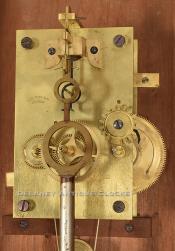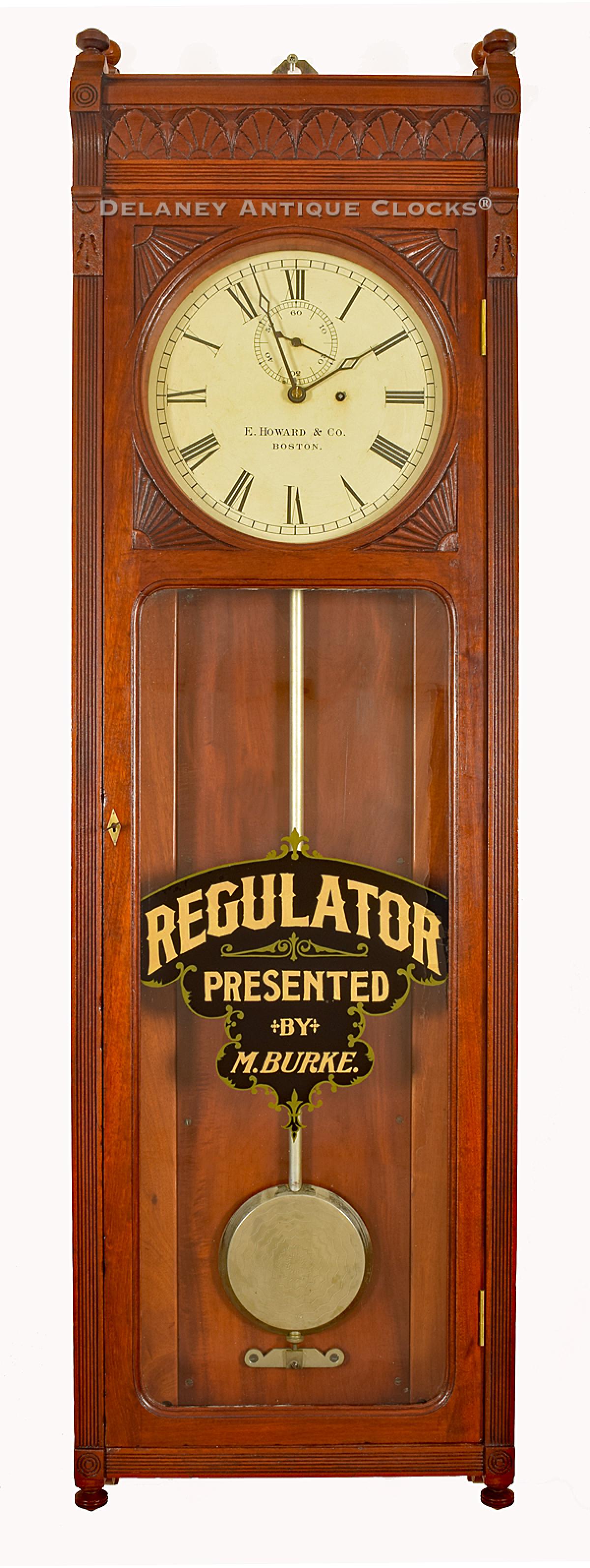E. Howard Clock Co. Model No. 72-12 Regulator in mahogany. "REGULATOR / PRESENTED / BY / M BRUKE." Dated: 11 – 1886. VV-120.
This clock was designed specifically for commercial use and provided excellent service. The weight-driven movement is secured to the backboard with two brass tabs, and a wooden strip helps support the weight of the works. The front plate is die-stamped by the Maker on the left side. This die-stamp reads, "E. Howard & Co., / BOSTON." The works are designed with a Graham Dead-beat escapement and maintaining or retaining power. The pendulum is supported at the top by a double-suspension spring. A Geneva Stop winding stop prevents one from overwinding the cast iron weight into the movement. The brass movement is designed to run for eight days. The pendulum rod is made of seasoned cherry and retains its original silver paint. The heavy bob is nickel-plated and features a damascened design or pattern on the front surface. This is in very good original condition. The enameled zinc dial measures approximately 12 inches in diameter and is original to this clock. It features the Maker's name, working location, and a true seconds register.
This mahogany case has been recently refinished. Appropriately, a shellac-based finish was applied, enhancing the natural color. The case design incorporates a number of carvings. The construction of this case is designed to minimize the effect that climate changes have on the ability of the movement to keep time. As a result, when these large regulator clocks are set up properly, the clock's ability to keep time varies by only seconds a month.
This example is 5 feet 4 inches long and was made in November 1886. It is dated with a die-stamp inside the case above the works.
The E. Howard shop records indicated that this clock was ordered through the Boston office on November 6th, 1886. It was sent to Boston Office. Two No. 72 models are recorded in the Howard records on that day. The first clock was to be constructed in an oak case and to have a 12-inch diameter dial. The second clock was recorded to be made in mahogany and was to have a 14-inch diameter dial. This order must have been misread, recorded, or changed on the factory floor because this 12-dial example is constructed in mahogany. This case is also stamped with the number 2, indicating that it was one of at least two clocks being made at that time. The catalog states that this clock originally sold for approximately $80.
Inventory number VV-120.
The E. Howard & Company succeeded the Howard & Davis firm in 1857. The Howard & Davis firm was comprised of Edward Howard and David Porter Davis and was established in 1842 in Roxbury, Massachusetts. Both men had just completed their clock apprenticeship under the guidance of Aaron Willard Jr in Boston. The Howard & Davis firm made high-grade clocks, precision balances, sewing machines, fire engines, and watches. After the dissolution of Howard & Davis, Edward Howard became Boston's leading manufacturer of weight-driven residential and commercial clocks. The firm also made a large number of tower clocks and watchman and salve clock systems. These sold well in the last quarter of the 1800s.
It has been said that the E. Howard Clock company never made an inexpensive clock, and everything they made was of very good quality. As a result, Howard clocks have become very collectible and are prized by their owners. Today, the E. Howard name enjoys outstanding name recognition.
For a more in-depth reading of Edward Howard and his various businesses, please read "Willard's Patent Time Pieces," written by Paul Foley.














